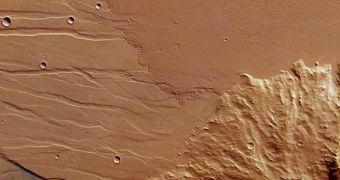Astronomers at the European Space Agency (ESA) have just released a new image of a Martian plain called Daedalia Planum, sections of which are filled with ancient lava flows. These hardened formations were at one point produced by the eruption of a massive volcano in the area.
According to the team behind this study, the plain is located near the eastern boundary of the Tharsis Montes volcanic region, which is known for having produced incredibly strong blasts in the past. However, ESA investigators do not believe that these volcanoes caused the lava flows visible here.
In all likelihood, these were created by the southernmost volcano in the range, which is located around 1,000 kilometers (621 miles) away from the area featured in this photo. Some geologists place the age of the lava flows at several tens of millions of years, which is fairly recent in geological time.
The photo was collected by the ESA Mars express spacecraft on November 28, 2013. It was released to the public alongside other images in a set, to showcase the geological diversity of the Martian surface. Scientists now believe that volcanic activity on Mars may have started around 4.5 billion years ago.
Mars Express has been studying the Red Planet since achieving orbital insertion around our neighboring world, on December 25, 2003. The mission launched aboard a Soyuz-FG rocket with a Fregat upper stage, from the Baikonur Cosmodrome in Kazakhstan, on June 2, 2003.

 14 DAY TRIAL //
14 DAY TRIAL //